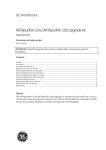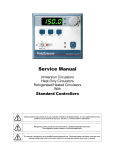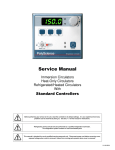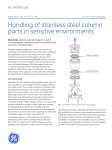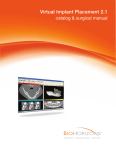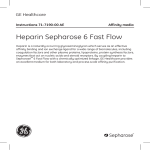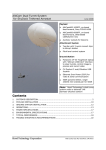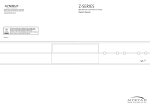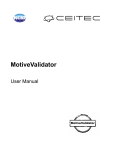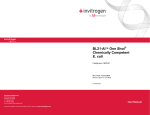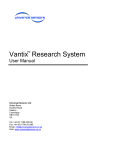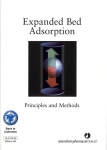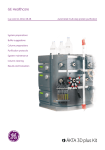Download GE Healthcare Q Sepharose XL Q Sepharose XL virus licensed SP
Transcript
GE Healthcare Instructions 71-5002-60 AE Ion exchange chromatography Q Sepharose XL Q Sepharose XL virus licensed SP Sepharose XL Q and SP Sepharose™ XL are ion exchange adsorbents specially designed to lower the manufacturing cost of biopharmaceuticals by raising the throughput of production scale chromatography processes. Q Sepharose XL virus licensed is in all aspects identical to Q Sepharose XL but in addition it provides a license to be used for virus purification as described in section ”Important Information”. These instructions will not further discriminate between the two products. Both adsorbents capture biomolecules directly from clarified feed-stocks. Their extremely high loading capacities, combined with high throughput, increase the productivity of manufacturing operations. In addition, Q and SP Sepharose XL belong to the BioProcess™ Media family. This ensures that they have both the performance and support to meet the tough demands of downstream processing. Key characteristics of Q and SP Sepharose XL include: • Capture biomolecules directly from clarified feed-stocks for effective initial purification • Dynamic binding capacities up to 10 fold higher than conventional ion exchangers • Easy scale-up to production • Belong to BioProcess Media family for perfomance and support to match their use in industrial downstream processing Contents 1. Characteristics 3 2. Recommendations and guidelines for packing columns 5 3. Evaluating packing 9 4. Method design and optimization 11 5. Cleaning-in-place (CIP) 12 6. Sanitization 13 7. Storage 13 8. Scaling up 14 9. Further information 14 10. Ordering information 15 Important Information Separating viral particles with, ”Q Sepharose XL” may require a license under United States pat 6,537,793 B2 and foreign equivalents owned by Centelion SAS. Such license is not included with the purchase of Q Sepharose XL product but is included with the purchase of Q Sepharose XL virus licensed, 17-5437-XX. With the purchase of ”Q Sepharose XL virus licensed” the customer is granted a free limited licence under US pat 6,537,793 B2 and foreign equivalents owned by Centelion SAS to sepatate viral particles solely through use of the product purchased. p. 1. Characteristics General Sepharose XL ion exchangers result from a continuous program to develop chromatography media that fulfil the stringent demands of industrial applications. With their extremely high loading capacities, high throughput and excellent physical and chemical stability, they are ideal to use in the capture stage of a downstream process (see background information). In addition, Q and SP Sepharose XL belong to the BioProcess Media family, which assures the process operator of a wide range of services tailor-made to support their use in commercial manufacture (see also background information). Background information Capture – the initial purification step A chromatographic process for purifying a biomolecule can be divided into three stages – Capture, Intermediate Purification and Polishing. Each has its own goals. The goal of Capture is to initially concentrate and purify the molecule of interest from crude or clarified feed-stock. Ion exchange is one of the techniques best suited to Capture. As the feed-stock may be viscous and contain proteases, high loading and throughput are needed ensure rapid processing prior to Intermediate Purification. BioProcess Media – media made for bioprocessing BioProcess Media are a specially selected range of separation media developed and supported for process scale chromatography. All media are produced following validated methods and are tested to ensure they meet the performance requirements of manufacturing industry. Special ordering and delivery routines assure reliable supply of production scale quantities. Regulatory Support Files contain information to assist process validation and submissions to regulatory authorities. BioProcess Media cover all purification steps from Capture to Polishing (see above). p. Properties Sepharose XL is based on a strong, cross-linked, bead-formed agarose matrix. Dextran chains are coupled to this agarose matrix. Strong Q and SP ion exchange groups are attached to the dextran through chemically stable ether bonds. Tables 1 and 2 list the main characteristics of Q Sepharose XL and SP Sepharose XL respectively. Table 1. Characteristics of Q Sepharose XL. Type of ion exchanger Ionic capacity Matrix structure Particle form Mean particle size Chemical stability1 Strong anion 0.18–0.25 mmol Cl-/ml adsorbent Cross-linked 6% agarose with bound dextran Spherical, 45–165 µm 90 µm – Stable in all commonly used aqueous buffers – 1 M NaOH – 20% ethanol – 6 M guanidine HCl Physical stability Recommended pH working range cleaning-in-place Avoid: – Long exposure (1 week, 20 °C) to pH <4 – Oxidizing agents Negligible volume variation due to changes in pH or ionic strength 2–12 2–14 Recommended working flow rate 300-500 cm/h Binding capacity2 >130 mg bovine serum albumin/ml adsorbent Temperature stability 4 to 40 °C Storage 20% ethanol 1 2 p. No significant change in ionic binding capacity and carbon content after 1 week storage at 40 °C. Breakthrough capacity in a 4.4 ml packed bed at a linear flow rate of 300 cm in 50 mM Tris-HCl, pH 7.5. Bed height 10 cm. 2 mg bovine serum albumin/ml. Table 2. Characteristics of SP Sepharose XL. Type of ion exchanger Ionic capacity Matrix structure Particle form Mean particle size Chemical stability1 Strong cation 0.18–0.25 mmol H+/ml adsorbent Cross-linked 6% agarose with bound dextran Spherical, 45–165 µm 90 µm – Stable in all commonly used aqueous buffers – 1 M NaOH – 20% ethanol – 6 M guanidine HCl Avoid: – Long exposure (1 week, 20 °C) to pH <4 – Oxidizing agents Physical stability Negligible volume variation due to changes in pH or ionic strength Recommended pH working range 4–13 cleaning-in-place 3–14 Recommended working flow rate 300-500 cm/h 2 Binding capacity >160 mg lysozyme/ml adsorbent Temperature stability 4 to 40 °C Storage 0.2 M sodium acetate in 20% ethanol 1 2 No significant change in ionic binding capacity or carbon content after 1 week storage at 40 °C. Breakthrough capacity in a 4.4 ml packed bed at a linear flow rate of 300 cm in 50 mM Glycine-HCl, pH 9.0 . Bed height 10 cm. 2 mg lysozyme/ml. 2. Recommendations and guidelines for packing columns Q and SP Sepharose XL are supplied as suspensions in 20% ethanol and 0.2 M sodium acetate in 20% ethanol respectively. Decant the solution and replace it with packing buffer before use. p. 2.1 Recommended columns Laboratory scale columns • XK 16/20 (16 mm ID) for bed volumes up to 30 ml at bed heights up to 15 cm. • XK 26/20 (26 mm ID) for bed volumes up to 80 ml at bed heights up to 15 cm. Production scale columns • BPG™ 100, 200 or 300 Columns (available for media volumes up to 45 litres). BPG columns are fitted with one adaptor. • INdEX™ variable bed columns: inner diameters from 70 to 200 mm; bed volumes up to 25 litres; bed heights max 61 cm. • Chromaflow™ variable and fixed bed columns. Inner diameters 280–2000 mm. 2.2 Packing laboratory scale columns (XK 16/20 and XK 26/20) 1. Assemble the column (and packing reservoir if necessary). 2. Eliminate air from the column dead spaces by flushing the end piece and adaptor with packing buffer. Make sure no air has been trapped under the column net. Close the column outlet leaving the net covered with packing buffer. 3. Resuspend the medium stored in its container by shaking (do not stirr sedimented medium). Mix the packing buffer with the medium to form a 50–70% slurry (sedimented bed volume/ slurry volume = 0.5-0.7). 4. Pour the slurry into the column in one continuous motion. Pouring the slurry down a glass rod held against the column wall will minimize the introduction of air bubbles. 5. If using a packing reservoir, immediately fill the remainder of the column and reservoir with packing buffer. Mount the adaptor or lid of the packing reservoir and connect the column to a pump. Avoid trapping air bubbles under the adaptor or in the inlet tubing. p. 6. Open the bottom outlet of the column and set the pump to run at the desired flow rate. Ideally, Sepharose XL media are packed at an initial flow rate of 250 cm/h until the medium has settled. 7. When the bed has stabilized, close the bottom valve and stop the pump. 8. If using a packing reservoir, disconnect the reservoir and fit the adaptor to the column. 9. With the adaptor inlet disconnected, push the adaptor approximately 2 mm into the stabilized bed, allowing the packing solution to flush the adaptor inlet. 10. Connect the pump, open the bottom outlet and continue packing at 600 cm/h for 15 min. The bed will compress further and a space will form between the bed surface and the adaptor. 11. Disconnect the column inlet and lower the adaptor approximately 2 mm into the bed. The column is now packed. 2.3 Packing process scale columns General packing recommendations Q and SP Sepharose XL are easy to pack since their rigidity allows the use of high flow rates. Columns can be packed in different ways depending on the type of column and equipment used. The different packing methods that are suitable for Sepharose XL ion exchangers are listed below. • Pressure packing: for columns with adaptors, for example BPG columns. • Hydraulic pressure packing, for example, INdEX columns. • Chromaflow packing method for standard Chromaflow columns Always read and follow the relevant column instruction manual carefully. How well the column is packed will have a major effect on the result of the separation. It is therefore very important to pack and test the column according to the following recommendations. Begin the packing procedure by determining the optimal packing flow rate. The following guidelines are for fixed bed height columns and columns with adaptors. p. Determining optimal packing flow rate The optimal packing flow rate is dependent on column size and type, bed height, packing solution and temperature. It must therefore be determined empirically for each individual system. To determine the optimal packing flow rate: 1. Calculate the exact amount of medium needed for the slurry (this is especially important for columns with fixed bed heights). The quantity of medium required per litre packed bed is approximately 1.15 litres sedimented medium. 2. Prepare the column exactly as for column packing. 3. Begin packing the column at a low flow rate (e.g. 30% of the expected maximum flow rate) and record the flow rate and back pressure when the bed is packed and the pressure has stabilized. 4. Increase the flow rate in small steps and record the flow rate and pressure at each step after the pressure has stabilized. 5. Continue the measurements until the maximum flow rate has been reached, i.e. when the flow rate levels off, indicating bed compression, or when the pressure reaches the pressure specification of the column used. 6. Plot pressure against flow rate as indicated in Fig. 1. The optimal packing flow rate/pressure is 70–100% of the maximum flow rate/pressure. The operational flow rate/pressure should be <70% of the packing flow rate/pressure. Note: For BPSS columns, first pack the column by suction packing at a low flow rate. Then determine the flow/pressure characteristics as above by pumping buffer with downward flow through the column. Packing your column Follow the detailed instructions in the Column User Manual which is supplied with your column. Copies can be ordered from your local representative. p. 3. Evaluating packing To check the quality of the packing and to monitor this during the working life of the column, test column efficiency directly after packing, at regular intervals afterwards, and when separation performance is seen to deteriorate. The best method of expressing the efficiency of a packed column is in terms of the height equivalent to a theoretical plate (HETP) and the asymmetry factor (A s). These values are easily determined by applying a sample such as 1% acetone solution to the column. Sodium chloride can also be used as a test substance. Use a concentration of 2.0 M NaCl in water with 0.5 M NaCl in water as eluent. It is of utmost importance to realize that the calculated plate number will vary according to the test conditions and it should therefore be used as a reference value only. It is also important that conditions and equipment are kept constant so that results are comparable. Changes in solute, solvent, eluent, sample volume, flow rate, liquid pathway, temperature, etc., will influence the results. For optimal results, the sample volume should be at maximum 2.5% of the column volume and the flow rate between 15 and 30 cm/h. If an acceptance limit is defined in relation to column performance, the column plate number can be used as one of the acceptance criteria for column use. Method for measuring HETP and As To avoid diluting the sample, apply it as close to the column inlet as possible. Conditions: Sample volume: Sample conc.: Flow rate: UV: 2.5% of the bed volume 1.0% v/v acetone 15 cm/h 280 nm, 1 cm, 0.1 AU Calculate HETP and As from the UV curve (or conductivity curve) as follows: HETP = L/N N = 5.54(Ve/Wh)2 p. where: L = Bed height (cm) N = number of theoretical plates Ve = Peak elution distance Wh = Peak width at half peak height Ve and Wh are in the same units. To facilitate comparing column performance, the concept of reduced plate height is often used. The reduced plate height is calculated as follows: HETP/d where: d is the diameter of the bead As a guideline, a value of <3 is normally acceptable. The peak should be symmetrical, and the asymmetry factor as close to 1 as possible (values between 0.8–1.5 are usually acceptable). A change in the shape of the peak is usually the first indication of bed deterioration due to use. Peak asymmetry factor calculation: A s = b/a where: a = 1st half peak width at 10% of peak height b = 2nd half peak width at 10% of peak height. Figure 1 shows a UV trace for acetone in a typical test chromatogram in which the HETP and A s values are calculated. p. 10 VR Wh 50% a b 10% Volume Column: BPG 300 Media: Sepharose 6 Fast Flow Bed height: 57.5 cm Bed volume: 40.6 litres Sample: 1.05 litres (1% acetone) Eluent: Distilled water Flow rate: 19 cm/h Wh = 0.9 HETP = 0.024 cm a: 0.90 b: 0.85 As: 0.94 Fig 1. UV trace for acetone in a typical test chromatogram showing the HETP and A s calculations. 4. Method design and optimization The main general aim of designing and optimizing an ion exchange separation is to identify conditions that promote binding of the highest possible amount of the target molecule, in the shortest possible time with highest possible product recovery. The very high loading capacities available throughout the structures of Q and SP Sepharose XL mean that they can bind exceptionally large amounts of target material. Special attention must therefore be given to optimizing elution conditions to avoid tailing when the eluting the protein of interest. Fully optimized elution also increases the effectiveness of CIP procedures, which will make the whole purification process more efficient. 4.1 Optimization of throughput The prime consideration when optimizing for highest possible throughput and productivity is to define the highest possible sample load over the shortest possible sample application time with acceptable loss in product recovery. The dynamic binding capacity for the target protein should be determined by frontal analysis using real process feed-stock. Since the dynamic binding capacity is a function of the linear flow rate applied during p. 11 sample application, the breakthrough capacity must be defined over a range of different flow rates to reveal the optimum level that gives highest throughput without excessive leakage of product at the column outlet. 5. Cleaning-in-place (CIP) Cleaning-in-place (CIP) is the removal from the purification system of very tightly bound, precipitated or denatured substances generated in previous purification cycles. If such contaminants accumulate on the column, they may affect its chromatographic properties. Severe fouling may also block the column, increasing back pressure and reducing flow rate. Regular CIP prevents the build up of these contaminants in the packed bed, and helps maintain the capacity, flow properties and general performance of Q and SP Sepharose XL. CIP protocols Precipitated or denatured substances: Wash with 2 column volumes of 6 M guanidine hydrochloride. Wash immediately with at least 5 column volumes of sterile filtered binding buffer at pH 7–8. Reversed flow direction. Hydrophobically bound substances: Wash the column with 2 column volumes of a non-ionic detergent (conc. 0.1%). Wash immediately with at least 5 column volumes of sterile filtered binding buffer at pH 7–8. Reversed flow direction. or Wash with 3–4 column volumes of 70% ethanol. Wash immediately with at least 5 column volumes of sterile filtered binding buffer at pH 7–8. Reversed flow direction. Apply increasing gradients to avoid air bubble formation when using high concentrations of organic solvents. These CIP protocols should be used as guidelines to formulate a cleaning protocol specific for the feed material applied to the column. Their frequency p. 12 of use will depend on the nature of the feed material. We recommended using a CIP procedure at least once every 5 cycles during normal use. Depending on the nature of the contaminants, different protocols may have to be used in combination. If fouling is severe, the protocols may have to be further optimized. 6. Sanitization Sanitization reduces microbial contamination of the bed to a minimum. Sanitization protocols Equilibrate with a buffer consisting of 2% hibitane digluconate and 20% ethanol. Allow to stand for 6 hours, then wash with at least 5 column volumes of sterile binding buffer. or Equilibrate with 70% ethanol. Allow to stand for 12 hours, then wash with at least 5 column volumes of sterile binding buffer. Note: Specific regulations may apply when using 70% ethanol as it may require the use of explosion-proof areas and equipment. 7. Storage Store unused media in the container at a temperature of +4 to +30 °C. Ensure that the screw top is fully tightened. Packed columns should be equilibrated in binding buffer containing 20% ethanol to prevent microbial growth. After storage, equilibrate with at least 5 bed volumes of start buffer before use. p. 13 8. Scaling up After optimizing the method at laboratory scale, the process can be scaled up. Some parameters will change, others will remain constant. 1. Select the bed volume according to required binding capacity. 2. Select a column diameter to obtain a bed height of 5–15 cm. This allows high flow rates to be used. The maximum flow rate is approximately inversely proportional to the bed height. Expect to operate at no more then 70% of the max. flow rate.) 3. Define the linear flow rate during sample application to ensure that the residence time will not be shorter than that established in the small scale experiments. The residence time is equal to the bed height (cm) divided by the linear flow rate (cm/h) applied during sample loading. 4. Keep sample concentration and gradient slope constant. The larger equipment used when scaling up may cause some deviations from the method optimized at small scale. In such cases, check the buffer delivery system and monitoring system for time delays or volume changes. Different lengths and diameters of outlet pipes can cause zone spreading on larger systems. 9. Further information Please read these instructions carefully before using Sepharose XL media. For further information visit www.gehealthcare.com or contact your GE Healthcare representative. p. 14 10. Ordering information Product Pack size Code No. Q Sepharose XL Q Sepharose XL virus licensed SP Sepharose XL 300 mL 5 L 60 L 25 mL 300 mL 1 L 5 L 300 mL 5 L 60 L 17-5072-01 17-5072-04 17-5072-60 17-5437-10 17-5437-01 17-5437-03 17-5437-04 17-5073-01 17-5073-04 17-5073-60 Q Sepharose XL is supplied as a suspension in 20% ethanol. SP Sepharose XL is supplied as a suspension in 20% ethanol and 0.2 M sodium acetate. For additional information, including Data Files, application references and Regulatory Support File, please contact your local GE Healthcare representative. p. 15 www.gehealthcare.com/protein-purification www.gehealthcare.com GE Healthcare Bio-Sciences AB Björkgatan 30 751 84 Uppsala Sweden GE Healthcare Europe GmbH Munzinger Strasse 5 D-79111 Freiburg Germany GE Healthcare UK Ltd Amersham Place Little Chalfont Buckinghamshire, HP7 9NA UK GE Healthcare Bio-Sciences Corp 800 Centennial Avenue P.O. Box 1327 Piscataway, NJ 08855-1327 USA GE Healthcare Bio-Sciences KK Sanken Bldg. 3-25-1, Hyakunincho Shinjuku-ku, Tokyo 169-0073 Japan BioProcess, BPG, Chromaflow, INdEX and Sepharose are trademarks of GE Healthcare companies. GE and GE monogram are trademarks of General Electric Company. GE Healthcare Bio-Sciences AB, a General Electric Company. Elanders Östervåla 2006 12345 Elanders Östervåla 2006 Elanders Östervåla 2006 71-5002-60 AE 02/2006 Elanders Östervåla 2006 Licensing information Separating viral particles with, ”Q Sepharose XL” may require a license under United States pat 6,537,793 B2 and foreign equivalents owned by Centelion SAS. Such license is not included with the purchase of Q Sepharose XL product but is included with the purchase of Q Sepharose XL virus licensed, 17-5437-XX. Elanders Östervåla 2006 12345 © 2006 General Electric Company – All rights reserved. Elanders Östervåla 2006 Elanders Östervåla 2006 12345 Elanders Östervåla 2006 12345 All goods and services are sold subject to the terms and conditions of sale of the company within GE Healthcare which supplies them. GE Healthcare reserves the right, subject to any regulatory and contractual approval, if required, to make changes in specifications and features shown herein, or discontinue the product described at any time without notice or obligation. Contact your local GE Healthcare representative for the most current information.
















